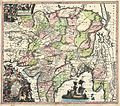Archivo:1740 Seutter Map of India, Pakistan, Tibet and Afghanistan - Geographicus - IndiaMogolis-seutter-1740.jpg
Apariencia

Tamaño de esta previsualización: 679 × 600 píxeles. Otras resoluciones: 272 × 240 píxeles · 543 × 480 píxeles · 869 × 768 píxeles · 1159 × 1024 píxeles · 2318 × 2048 píxeles · 5000 × 4418 píxeles.
Ver la imagen en su resolución original (5000 × 4418 píxeles; tamaño de archivo: 8,42 MB; tipo MIME: image/jpeg)
Historial del archivo
Haz clic sobre una fecha y hora para ver el archivo tal como apareció en ese momento.
| Fecha y hora | Miniatura | Dimensiones | Usuario | Comentario | |
|---|---|---|---|---|---|
| actual | 20:49 22 mar 2011 |  | 5000 × 4418 (8,42 MB) | BotMultichillT | {{subst:User:Multichill/Geographicus |link=http://www.geographicus.com/P/AntiqueMap/IndiaMogolis-seutter-1740 |product_name=1740 Seutter Map of India, Pakistan, Tibet and Afghanistan |map_title=Imperii Magni Mogolis sive Indici Padschach, juxta recentiiss |
Usos del archivo
La siguiente página usa este archivo:
Uso global del archivo
Las wikis siguientes utilizan este archivo:
- Uso en ar.wikipedia.org
- Uso en beta.wikiversity.org
- Uso en bn.wikipedia.org
- Uso en ca.wikipedia.org
- Uso en cs.wikipedia.org
- Uso en el.wikipedia.org
- Uso en en.wikipedia.org
- Uso en eo.wikipedia.org
- Uso en incubator.wikimedia.org
- Uso en it.wikipedia.org
- Uso en pnb.wikipedia.org
- Uso en ru.wikipedia.org
- Uso en te.wikipedia.org
- Uso en ur.wikipedia.org
- Uso en www.wikidata.org



